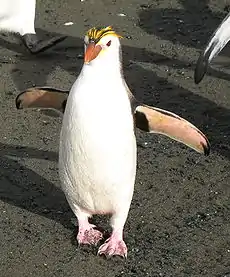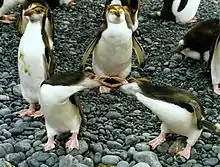Royal penguin
The royal penguin (Eudyptes schlegeli) is a subspecies of penguin, which can be found on the sub-Antarctic Macquarie Island and adjacent islands. It is a localised variant of the Macaroni penguin. The International Union for Conservation of Nature (IUCN) classifies the royal penguin as near threatened.[1] The scientific name commemorates the German zoologist Hermann Schlegel.
| Royal penguin | |
|---|---|
 | |
| Scientific classification | |
| Kingdom: | Animalia |
| Phylum: | Chordata |
| Class: | Aves |
| Order: | Sphenisciformes |
| Family: | Spheniscidae |
| Genus: | Eudyptes |
| Species: | E. schlegeli |
| Binomial name | |
| Eudyptes schlegeli Finsch, 1876 | |
.png.webp) | |
| Distribution royal penguin | |
Description

It is one of the crested penguins (a different genus from the similarly named king or emperor penguins). There is some controversy over whether royal penguins are a subspecies of macaroni penguins. Individuals of the two groups have been known to interbreed, though this is a relatively rare occurrence. Indeed, other penguins have been known to form mixed-species pairs in the wild.
They inhabit the waters surrounding Antarctica. Royals look very much like macaroni penguins, but have a white face and chin instead of the macaronis' black visage. They are 65–76 cm (26–30 in) long and weigh 3–8 kg (6.6–17.6 lb).[2][3] Males are larger than females. Royal penguins breed only on Macquarie Island and, like other penguins, spend much of their time at sea, where they are assumed to be pelagic.
Breeding
Royal penguins nest on beaches or on bare areas on slopes covered with vegetation. Like most seabirds they are colonial, nesting in scrapes on the ground up to a mile inland. The breeding season begins in September with laying following in October. Though royals typically lay two eggs, only one usually survives. The egg is kept warm by both parents for around 35 days. This is done by rotating 12-day shifts. After hatching, the male cares for the chick for 2 to 3 weeks, when the female returns with food for both of them. If the female is delayed or fails to return to the colony, the chick will die. At about one month old, the chicks begin to group together for warmth and safety. Both parents continue to feed chicks two to three times a day. When the chicks are just over two months old, they will have grown their adult plumage and will leave the colony to go to sea to feed on their own.
Diet

Royal penguins feed on krill, small fish, and small amounts of squid.
Threats
Royal penguins as a species are classified as near threatened by the IUCN, with high risk of endangerment in the wild.[1] Historically they were hunted for their oil; between 1870 and 1919 the government of Tasmania issuing licences for hunting them, with an average of 150,000 penguins (both royal and king) being taken each year. At the peak of the industry in 1905, the plant established on Macquarie Island was processing 2000 penguins at a time, with each penguin yielding about half a litre of oil.[4]
Since the end of penguin hunting on Macquarie the numbers have climbed to 850,000 pairs. Before hunting started, there were three million penguins on the island (both royal and king).[4]
References
- BirdLife International (2015). "Eudyptes schlegeli". IUCN Red List of Threatened Species. 2015. Retrieved 24 January 2016.CS1 maint: ref=harv (link)
- (2011).
- Archived 2013-01-09 at the Wayback Machine (2011).
- Commonwealth Marine Reserves - Home Page Archived 2012-10-28 at the Wayback Machine. Environment.gov.au. Retrieved on 2013-09-27.
Further reading
- del Hoyo, J., Elliot, A., Sargatal, J., eds (1992) Handbook of the Birds of the World, Volume One Ostrich to Ducks, ISBN 84-87334-10-5
External links
| Wikispecies has information related to Eudyptes schlegeli. |
| Wikimedia Commons has media related to Eudyptes schlegeli. |
- Royal penguins on PenguinWorld
- BirdLife species factsheet
- ARKive - images and movies of the royal penguin (Eudyptes schlegeli)
- Australian Antarctic Division: Unusual penguins Contains picture of hybrid penguins and penguins with non-standard plumage
- www.pinguins.info Information about all species of penguins
